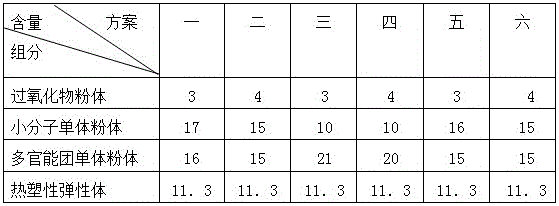Method for preparing plastic formwork from waste polypropylene granules through modification
A technology of waste polypropylene and plastic templates, which is applied in the field of plastic templates made of waste polypropylene particles, which can solve the problems of rigidity and heat-resistant temperature drop, high price, compatibility, etc., and achieve a wide range of product shape adjustment, The effect of improving melt strength and simplifying the process flow
- Summary
- Abstract
- Description
- Claims
- Application Information
AI Technical Summary
Problems solved by technology
Method used
Image
Examples
Embodiment 1 Embodiment 6
[0022] A method for making plastic templates by modifying waste polypropylene particles, which is produced by mixing and extruding the following components, and the content of each component is calculated in parts by weight (see attached table 1):
[0023] 85-90 parts of recycled polypropylene composite plastic particles, 10-15 parts of modified masterbatch;
[0024] The modified masterbatch is a masterbatch made by coating the outer surface of the activated inorganic powder with peroxide, small molecular monomers, and multifunctional monomers and then wrapping thermoplastic elastomers to form a modified masterbatch. The content of each component is calculated in parts by weight (see attached table 2):
[0025] 1. 3 parts of peroxide powder, 17 parts of acrylic acid (AA) powder, 16 parts of thiuram powder, 11.3 parts of thermoplastic elastomer;
[0026] 2. 4 parts of peroxide powder, 15 parts of acrylic acid (AA) powder, 15 parts of thiuram powder, and 11.3 parts of thermopla...
PUM
| Property | Measurement | Unit |
|---|---|---|
| thickness | aaaaa | aaaaa |
Abstract
Description
Claims
Application Information
 Login to View More
Login to View More - R&D
- Intellectual Property
- Life Sciences
- Materials
- Tech Scout
- Unparalleled Data Quality
- Higher Quality Content
- 60% Fewer Hallucinations
Browse by: Latest US Patents, China's latest patents, Technical Efficacy Thesaurus, Application Domain, Technology Topic, Popular Technical Reports.
© 2025 PatSnap. All rights reserved.Legal|Privacy policy|Modern Slavery Act Transparency Statement|Sitemap|About US| Contact US: help@patsnap.com



